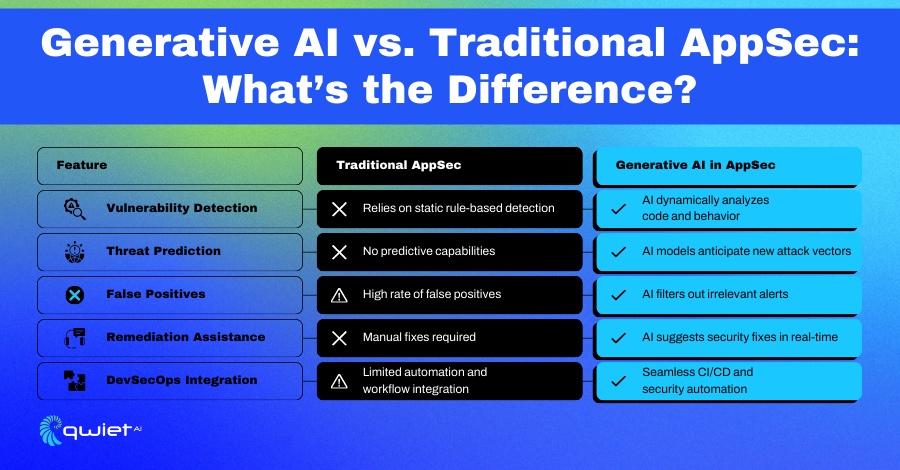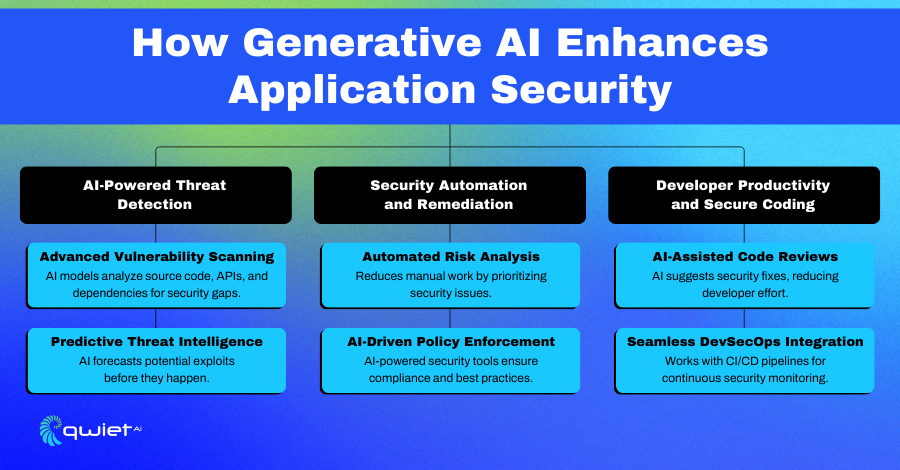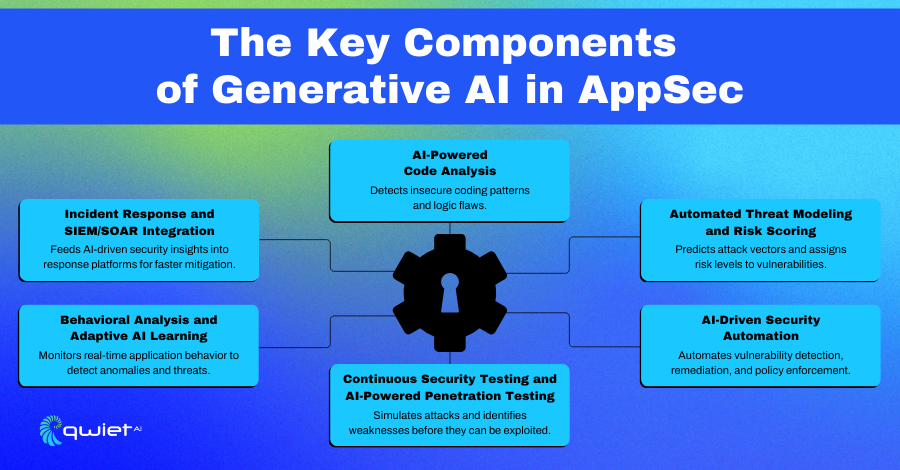Key Takeaways
- Proactive Threat Detection: Generative AI enhances security by identifying vulnerabilities in application code and predicting potential attack vectors before they are exploited.
- Automated Security Insights: AI-driven analysis reduces manual efforts by automating vulnerability detection, remediation suggestions, and security policy enforcement.
- Improved Developer Productivity: Generative AI integrates seamlessly into DevSecOps, helping teams write more secure code and streamline security testing.
What is Generative AI in AppSec?

Generative AI in Application Security (AppSec) leverages advanced machine learning models to analyze, predict, and address security vulnerabilities in software applications. These AI models go beyond traditional rule-based detection by dynamically assessing code patterns, configurations, and user behaviors, offering a more adaptive and precise approach to identifying risks. Unlike static scanners, which rely on predefined rules, generative AI tools adapt and learn from real-world data to spot issues that may otherwise be missed.
This capability significantly enhances real-time risk mitigation. AI-powered security tools can quickly detect emerging threats and provide immediate insights, helping security teams respond faster and reduce their exposure to potential attacks. The combination of predictive analysis and contextual understanding enables organizations to maintain stronger security postures without slowing development workflows.
Why Does Generative AI Matter in AppSec?

Security
Generative AI significantly upgrades how security teams detect and address vulnerabilities. Traditional scanners often rely on known patterns and rules, leaving gaps in coverage. On the other hand, AI models analyze code repositories, APIs, and dependencies to uncover security risks that might otherwise go unnoticed. By continuously learning from real-world data, these models can spot weaknesses more accurately, helping teams identify risks earlier in development.
Threat prediction is another powerful capability. Generative AI simulates potential attack scenarios to highlight areas of weakness and suggest ways to strengthen security. Its ability to adapt in real time to new threats gives security teams a significant advantage.
Rather than waiting for known vulnerabilities to surface, AI-driven insights help organizations adjust their security strategies on the fly, staying ahead of evolving attack methods and reducing overall risk exposure.
Operational Benefits
Generative AI smooths development workflows by helping developers catch and fix security issues as they code. AI-powered automated code review tools can spot insecure coding patterns in real-time and suggest more secure alternatives.
This helps teams avoid common vulnerabilities without slowing down the development process, allowing developers to focus on writing better code. At the same time, AI handles much of the heavy lifting on the security side.
It also reduces noise for security teams.
Traditional tools often generate many irrelevant alerts. AI’s machine learning models filter out those false positives, leaving teams with fewer but more meaningful alerts to investigate. Seamless integration with CI/CD pipelines means these security checks happen without interrupting development speed, helping DevSecOps teams maintain their workflow while keeping security front and center.
Compliance and Governance
Aligning with security standards like GDPR, ISO 27001, and NIST can be challenging, especially when managing large environments. AI-driven tools simplify this process by automatically generating security reports that meet regulatory requirements.
These reports are always up to date, eliminating the need for manual documentation and reducing the workload on security teams. With audit-ready logs, teams can respond to compliance requests quickly and confidently.
Continuous monitoring keeps everything on track. AI tracks real-time security policies and application behavior, identifying potential compliance gaps or misconfigurations. When an issue needs attention, it flags it immediately, helping teams correct it before it escalates. This makes maintaining security standards more manageable while supporting long-term governance efforts.
Components of Generative AI in AppSec

AI-Powered Code Analysis
Large language models (LLMs) enable AI to precisely analyze source code, identifying insecure patterns and logic flaws that could lead to vulnerabilities. These tools don’t just flag issues—they provide developers with actionable, context-aware suggestions to fix them. By incorporating industry best practices into these recommendations, developers can address security concerns directly within their workflow, making code safer and more reliable.
Threat Modeling and Risk Assessment
AI enhances threat modeling by simulating potential attack scenarios based on an application’s architecture and dependencies. These simulations allow teams to understand how vulnerabilities might be exploited in real-world conditions. With dynamic risk scoring, each vulnerability is prioritized by its severity and impact, helping teams focus on addressing the most critical issues first, saving time, and reducing overall risk.
Self-Learning Security Models
AI constantly evolves through self-learning algorithms that adapt to emerging attack trends and techniques. This enables it to refine its detection capabilities, staying effective even as threats change. Analyzing application behavior can also identify anomalies that may indicate potential security risks, giving teams early warning signs of threats that might otherwise go unnoticed.
Automated Security Testing
AI-driven penetration testing simulates attacks to uncover vulnerabilities in web applications, APIs, and mobile apps. This proactive approach helps identify weaknesses before attackers can exploit them. Continuous security scanning is integrated throughout the development lifecycle, ensuring vulnerabilities are detected and mitigated at every stage, from initial development to production.
Incident Response and Threat Mitigation
When threats are detected, AI provides automated remediation guidance, offering patches, configuration updates, and other security controls tailored to the issue. It integrates seamlessly with platforms like SIEM and SOAR, feeding actionable insights into existing monitoring and response workflows—this streamlines incident response, enabling teams to act quickly and effectively to neutralize threats.
Conclusion
Generative AI reshapes application security by offering proactive threat detection, automated insights, and more effective vulnerability management. Its continuously analyzing and adapting ability helps organizations uncover hidden risks, predict potential attacks, and respond faster than ever. When integrated into DevSecOps, AI-driven security measures reduce overall risk, simplify compliance efforts, and make security processes more efficient without slowing development. For teams looking to stay ahead of evolving threats, AI provides the tools needed to keep applications secure and resilient. If you’re ready to see how AI can strengthen your AppSec strategy, book a demo with Qwiet and experience the future of security firsthand.
FAQs
1. What is Generative AI in AppSec?
Generative AI in AppSec uses machine learning models to analyze code, behavior, and attack patterns to detect, predict, and mitigate application security vulnerabilities.
2. How does it improve vulnerability detection?
AI models continuously analyze code and security data to identify real-time risks, reducing reliance on manual security reviews and traditional scanning methods.
3. Can Generative AI help with compliance?
Yes, it supports compliance with regulations like GDPR and ISO 27001 by providing detailed security logs, automated risk assessments, and real-time monitoring.
Read Next
No related posts.
About Qwiet AI
Qwiet AI empowers developers and AppSec teams to dramatically reduce risk by quickly finding and fixing the vulnerabilities most likely to reach their applications and ignoring reported vulnerabilities that pose little risk. Industry-leading accuracy allows developers to focus on security fixes that matter and improve code velocity while enabling AppSec engineers to shift security left.
A unified code security platform, Qwiet AI scans for attack context across custom code, APIs, OSS, containers, internal microservices, and first-party business logic by combining results of the company’s and Intelligent Software Composition Analysis (SCA). Using its unique graph database that combines code attributes and analyzes actual attack paths based on real application architecture, Qwiet AI then provides detailed guidance on risk remediation within existing development workflows and tooling. Teams that use Qwiet AI ship more secure code, faster. Backed by SYN Ventures, Bain Capital Ventures, Blackstone, Mayfield, Thomvest Ventures, and SineWave Ventures, Qwiet AI is based in Santa Clara, California. For information, visit: https://qwietdev.wpengine.com
